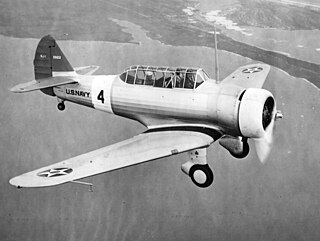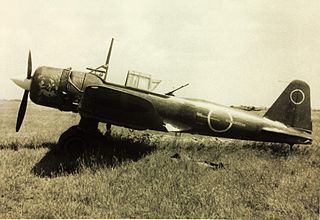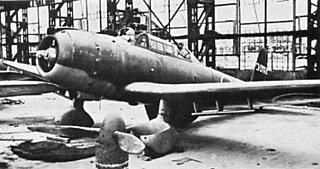
The Kyūshū J7W Shinden is a World War II Japanese propeller-driven prototype fighter plane with wings at the rear of the fuselage, a nose-mounted canard, and a pusher engine.

The North American Aviation T-6 Texan is an American single-engined advanced trainer aircraft used to train pilots of the United States Army Air Forces (USAAF), United States Navy, Royal Air Force, Royal Canadian Air Force and other air forces of the British Commonwealth during World War II and into the 1970s. Designed by North American Aviation, the T-6 is known by a variety of designations depending on the model and operating air force. The United States Army Air Corps (USAAC) and USAAF designated it as the AT-6, the United States Navy the SNJ, and British Commonwealth air forces the Harvard, the name by which it is best known outside the US. Starting in 1948, the new United States Air Force (USAF) designated it the T-6, with the USN following in 1962. It remains a popular warbird used for airshow demonstrations and static displays. It has also been used many times to simulate various historical aircraft, including the Japanese Mitsubishi A6M Zero. A total of 15,495 T-6s of all variants were built.

The Kyūshū Q1WTōkai was a land-based anti-submarine patrol bomber aircraft developed for the Imperial Japanese Navy in World War II. The Allied reporting name was Lorna. Although similar in appearance to the German Junkers Ju 88 medium bomber, the Q1W was a much smaller aircraft with significantly different design details.

The North American Aviation NA-16 was the first trainer aircraft built by North American Aviation, and was the beginning of a line of closely related North American trainer aircraft that would eventually number more than 17,000 examples, notably the T-6 Texan family.

The North American BT-9 was the United States Army Air Corps (USAAC) designation for a low-wing single engine monoplane primary trainer aircraft that served before and during World War II.

The Kyūshū K11W Shiragiku made by the Kyūshū Aircraft Company, was a land-based bombing trainer aircraft which served in the Imperial Japanese Navy Air Service in the latter years of World War II. As indicated by its Japanese designation, "training aircraft for on-board work", it was designed to train crews in operating equipment for bombing, navigation, and communication, as well as navigation techniques. A total of 798 K11Ws were manufactured, including a small number of K11W2 ASW and transport aircraft alongside the K11W1 trainer variant. These aircraft were also used in kamikaze missions during the last stages of the Pacific War.

The Mitsubishi Ki-57 was a Japanese passenger transport aircraft, developed from the Ki-21 bomber, during the early 1940s.

The Mitsubishi Ki-51 was a light bomber/dive bomber in service with the Imperial Japanese Army during World War II. It first flew in mid-1939. Initially deployed against Chinese forces, it proved to be too slow to hold up against the fighter aircraft of the other Allied powers. However, it performed a useful ground-attack role in the China-Burma-India theater, notably from airfields too rough for many other aircraft. As the war drew to a close, the Japanese began using them in kamikaze attacks. Total production was around 2,385 units.

The Mitsubishi B1M was a Japanese torpedo bomber of the 1920s, also known as the Navy Type 13 Carrier-Borne Attack Aircraft. It was designed and built by Mitsubishi and used in combat against China. The aircraft was used by the air services of the Imperial Japanese Navy and Imperial Japanese Army.

The I.Ae. 22 DL was an Argentine advanced training aircraft designed by the Instituto Aerotecnico in 1943, with a wooden structure, which resembled the North American NA-16.

The Yokosuka B4Y was a carrier-borne torpedo bomber used by the Imperial Japanese Navy Air Service from 1936 to 1943. The B4Y replaced the Mitsubishi B2M2 and the Yokosuka B3Y, and was the last biplane bomber used operationally by the Imperial Japanese Navy. The Allied reporting name was "Jean".

The Nakajima G5N Shinzan was a four-engined long-range heavy bomber designed and built for the Imperial Japanese Navy prior to World War II. The Navy designation was "Experimental 13-Shi Attack Bomber"; the Allied code name was "Liz".

The Mitsubishi Ki-30 was a Japanese light bomber of World War II. It was a single-engine, mid-wing, cantilever monoplane of stressed-skin construction with a fixed tailwheel undercarriage and a long transparent cockpit canopy. The type had significance in being the first Japanese aircraft to be powered by a modern two-row radial engine. During the war, it was known by the Allies by the name Ann.

The Kawanishi E7K was a Japanese three-seat reconnaissance seaplane mainly in use during the 1930s. It was allocated the reporting name Alf by the Allies of World War II.

The Mitsubishi Ki-83 (キ83) was a Japanese experimental long range heavy fighter designed near the end of World War II. It did not reach production status.

The Mitsubishi K3M was a trainer built by Mitsubishi which was used by the Imperial Japanese Navy in an extremely wide variety of roles, including light transport, liaison aircraft, utility aircraft and occasionally light bomber. Its Allied reporting name was Pine.
The Nakajima B3N was a prototype Japanese carrier-based torpedo-bomber aircraft of the 1930s. A single-engined biplane with a crew of three, it was unsuccessful, only two being built.

The Yokosuka D3Y Myojo was a Japanese two-seat dive bomber/trainer designed and built by the Yokosuka Naval Air Technical Arsenal. Derived from the Aichi D3A, it was made nearly entirely of wood in an attempt to conserve valuable resources. Upon Japan's surrender, the project came to a halt with only a few aircraft delivered as the Navy Type 99 Bomber Trainer Myojo Model 22.

The Mitsubishi 3MT5 was a Japanese bomber of the 1930s. It was a twin-engined biplane that was intended to operate from Japanese aircraft carriers, but proved to be unsuitable for carrier use, and the eleven aircraft built were instead used as land-based trainers.

The North American NA-64 is a low-wing single piston engine monoplane advanced trainer aircraft that was built for the French Air Force and French Navy, served with the Royal Canadian Air Force, and with the Luftwaffe as a captured aircraft during World War II.



















